State of Decay 2 Review
Nothing goes together quite like zombies and math.
This article first appeared on USgamer, a partner publication of VG247. Some content, such as this article, has been migrated to VG247 for posterity after USgamer's closure - but it has not been edited or further vetted by the VG247 team.
If you zone out on something too long, one might jokingly call you a zombie. You're in a mindless state, your only desire is whatever lies ahead of you—a bingeable Netflix show, a Platinum trophy or big achievement in a video game, a good meal. Whatever's directly on the horizon is all that's in your field of view, and you'll do anything to attain it. Like a zombie on the hunt for its next human-shaped meal.
Playing State of Decay 2 this past week, I often felt like a zombie. My mind went blank as it settled into the game's core loop: keeping supplies stocked and morale high. It sounds simple, but all things considered, it's actually not; and I'm a sucker for a good ass game loop.
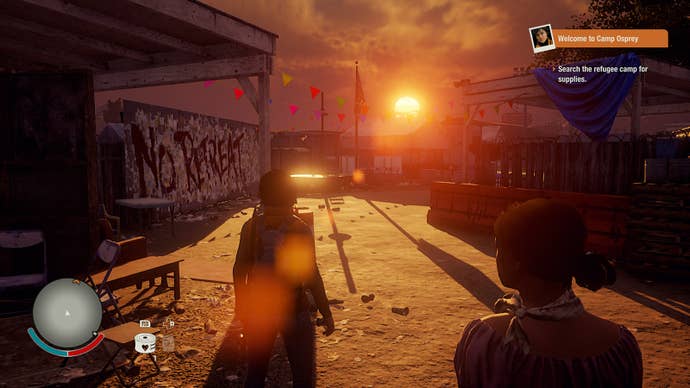
Nothing could dissuade me from satiating my ever-growing community, from my upgraded base to my many outposts. With every perilous expedition out I made for supplies like food, my community persisted in the desolate zombie-overrun towns. And like all post-apocalyptic fiction, my team was heavily diverse in every way possible. As for their unique character traits, one was a "Halo Champion" (I'm guessing in their previous life), while another was "Into Ultimate Frisbee" and had solid "cardio" skill to match. In addition to sillier traits, every character has a variety of strengths and weaknesses too.
State of Decay 2 is a game about managing a small community in the face of omnipresent zombies, colloquially referred to as "zees" in the in-game world. You switch freely between different community members, and they level up the more you play as them. For example, if one shoots a gun a lot, they'll level up in their shooting faster with a specialized skill being unlocked if they max it out, and so on.
Overall, it's a game with a lot of numbers thrown at the player at all times, and initially it seems confounding. You can almost feel the math permeating at all times beneath the surfaces of randomly generated community members, other NPCs, quests, loot supply statistics, and, most importantly, your ever-growing base building. But the more I played, the easier it all became to manage. At the start I was baffled by the amount of icons, whereas hours later the moment I knew my food was running low, I put my community on rations and eyeballed the map to pinpoint unlooted places that had a possibility of turning up a much-needed food supply sack. If it was urgent, I'd make sure my community member with the highest "cardio," or stamina, was at my behest because we were guaranteed to do a whole lot of running.
The base building in State of Decay 2, what you're maintaining for the community's sake the entire game, depends all on influence points. Influence points are earned in a multitude of ways. Sometimes in trading goods with other survivors you meet across the map, other times in helping out other NPCs by completing favors. With influence points, players can buy outposts, a new base, and even other goods from survivors outside of your community. It's a cost and effect currency system, with every purchase weighed with the pros and cons of what your community needs most at any moment. Since every playthrough is inherently different because of the game's dynamicly generated quests and NPCs, there's a lot of conundrums (like a random community member kicking over a fuel can and apologizing for it on the radio—gesturing that now it's your job to find replacement fuel) and surprise successes (like your base being adequately defended from zombie attacks) that can occur on any run.


That's the core loop of State of Decay 2. You climb big ladders to clamber on top of billboards and cell towers, and pinpoint all the nearby locations in your vicinity. There may be an abandoned diner that would be great for food, or an auto shop for fuel, or a decent sized house for with more beds for another outpost. Claiming outposts across the map is integral to success in State of Decay 2, as it gives you another location to dump your scavenging inventory into and gives you a specific resource that's periodically sent back to your homebase too. If you utilize outposts stupidly, like having three auto shops as outposts for some reason, it could spell disaster for your community. Luckily, the game communicates the sometimes-complicated needs of your community well, in addition to the skills to look out for when potentially recruiting new a survivor to your community too. And sometimes, you'll even have to decide to turn someone away if they don't have a useful skill to fit in with what the community needs, adding a moral consequence.
If this all sounds familiar because you played the first State of Decay, that's because it is. While it's far more accessible and less obtuse thanks to better UI and tutorials, those hoping for a drastic overhaul of the first game might come away disappointed. State of Decay 2 introduces co-op multiplayer, which is a huge addition to the last game's single-player only way of playing. The game has three openly playable maps instead of just one. Any of your community's members can be promoted to being a leader, with special unique perks to match. While the new Blood Plague zombies (who can infect you if you take too much damage from them) are new to the sequel, otherwise the moment-to-moment of State of Decay 2 will feel awfully familiar for veterans to the series.
Death remains permanent in State of Decay 2, just as it was in the first game. It's easy to get attached to a particular survivor after playing with them for awhile. Kind of like some JRPGs, you have a whole party of community members you can freely swap between. It's crucial to swap too, because like human beings, these virtual randomly generated people get fatigued and have to rest sometimes. Managing the community is a constant balancing act because of this. No matter what, someone is always guaranteed to be recovering from fatigue (usually hitting a character after playing as them for 45 minutes or so, causing their max stamina meter to deplete overtime), or resting in the makeshift infirmary if they're suffering from an injury or zombie infection. With every community member's skills, considering who to play as and bring as your NPC back-up follower is essential before venturing out to collect supplies, kill looming zombie hordes, or do whatever other task. For instance, if you take two survivors who are horrible at fighting on the road, then you might have a couple more gravestones to add to your community in the near future.
Of course, I had favorites in my first community. The first community member I lost was by accident. Myself and one of my initial party members went to clear out a Plague Heart—giant fleshy beacons that are the source of the most brutal zombies you'll find around—when we quickly found ourselves overwhelmed. I threw molotovs liberally at the Plague Heart, firing my gun and making a stupid amount of noise in doing so, thus attracting way more zombies. Meanwhile, my NPC partner quickly got eaten alive before turning into a zombie themselves. I had to put them down, loot their corpse, and bid adieu.
I felt bad about it, even though I didn't really have any emotional connection to them. Later, my most leveled up community member was shot and killed after accidentally stumbling on a house that another enclave of NPC survivors had saddled up in—they were hostile, obviously, and I hadn't reloaded my gun since whenever I last used it. And just like that, my strongest community member was gone forever thanks to my stupidity. They wouldn't be able to become the leader of my community as I was planning; they wouldn't see the end of this community's playthrough after clearing out the map's ten Plague Hearts while establishing their "legacy" through certain goals; they wouldn't be able to be carried over into my future communities. They were just dead and gone.
After all, death is inevitable in State of Decay 2. No matter what you're doomed to slip-up, or an unforeseen problem is fated to arise and f**k your whole life up. From a survivor being unhappy and starting fights within your community because there's no gym built, to a neighborly enclave getting mad at you for not helping them out and stealing your meds as payback, there's always some unfortunate trouble brewing in the background, even if you don't realize it.
With all those dynamic story quests (like seeking out a random survivor's aunt), there are bound to be some hiccups. And hiccups there are in the form of all-too common glitches. On multiple occasions at night, a character's flashlight would glitch out, flicking on and off for eternity even after switching back and forth between the random fellow survivor I brought along for the journey. Since there's no sleep option in the game, exploring and foraging for goods at night is a necessary evil—even if it's far more tense and terrifying to rummage through a deserted gas station in the dead of night.
In other instances, I stumbled upon glitched out zombies flying high in the air. Once a car I was driving hit a small barricade and flipped all the way over for some reason. While none of the finicky elements of the game directly halted my playthroughs of the game outside of minor inconveniences (and even if they did, the handy radio menu has an option to skip backwards two minutes in time if players get stuck), they remained a nuisance. In today's age of day one patches and live service games though, it's possible that these bugs will be patched out within the game's first couple weeks or so.
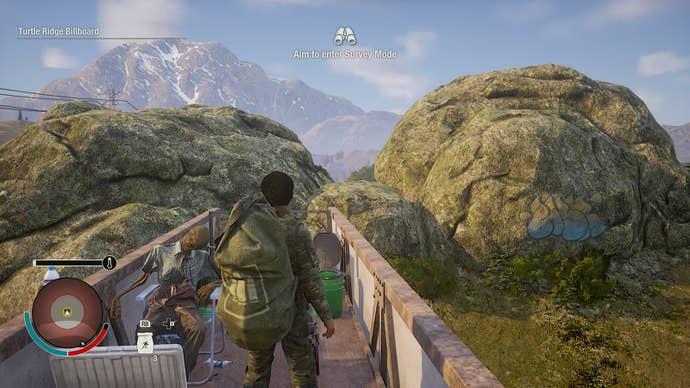
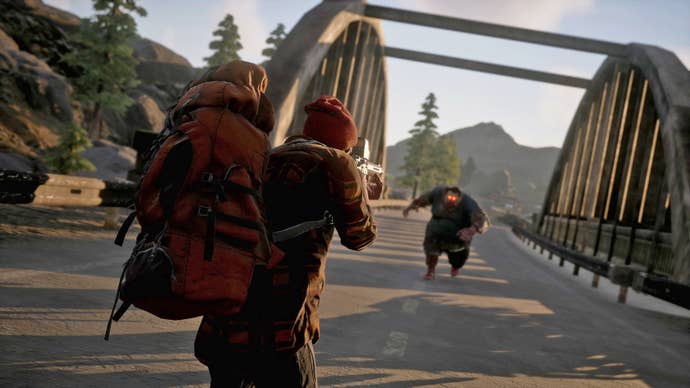
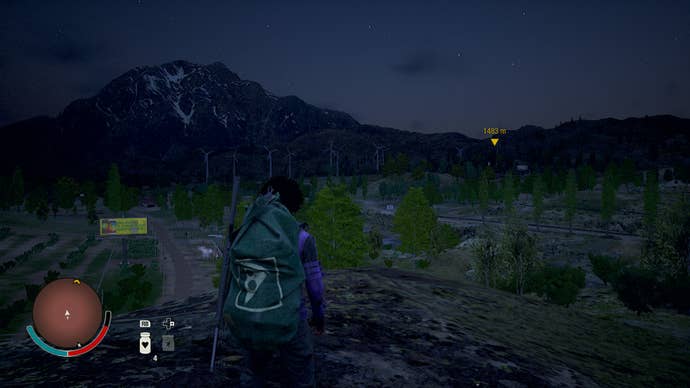
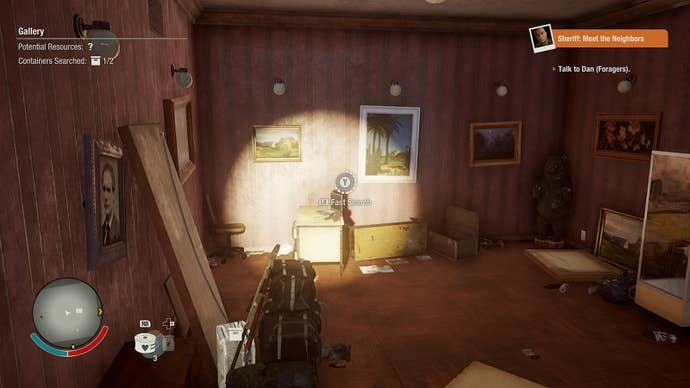
Co-op multiplayer, arguably the game's biggest addition from its predecessor, at least runs smoothly outside of a few instances of the frame rate dipping. It's relatively simple in practice too. If you don't want to play with anyone else and would rather remain in solitude, you can toggle your game to always be offline. If you want to leave the option open, you can turn on the invite only mode. Invite only allows players who "volunteer" to join a match (accessible in the radio menu) to join a random game, and you can choose to accept the request or not—or even volunteer yourself to see if any other random player will have you. If you only want to play with fellow friends from Xbox Live, then that's an option too in "Friends Only."
While I never got a chance to play with people I actually know, State of Decay 2 is arguably at its best when shared with other players. There's no sweeter game space to share with other players than a tense zombie-overrun rural countryside where other non-A.I. fools are always willing to blow your stealth cover at opportune moments. While it's disappointing that you can't poke out of the windows of cars to shoot at the zombies you zip by, it's just a mild complaint. In addition to keeping and having access to all the loot you get in the host player's game, players also accrue special influence points for their base back home. Unlike some games where progress of drop-in co-op doesn't carry over, in State of Decay 2 giving a helping hand is made worthwhile.
It's the core loop of the management sim where State of Decay 2 really clicks, though I imagine it'll be overwhelming for some players just as the first game was. With morale, hunger, health, and dozens of other statistics to constantly keep an eye on in addition to the always-present zombie apocalypse on your doorstep, State of Decay 2 is a game that rewards the smartest of players. And that's a good thing too, because I'm starting to feel like my entire school life was a lie and I'm actually good at math. Or at least, I'm generally okay at managing the resources of a post-apocalyptic community who eats a lot of pizza.
ConclusionIf you can deal with a healthy dose of bugs, State of Decay 2 is an extremely satisfying and unpredictable management sim with a solid action-survival game laid on top. The sequel's improved UI, new multiplayer component, and additional maps help it stand out from its predecessor, even if the moment-to-moment is largely the same.










